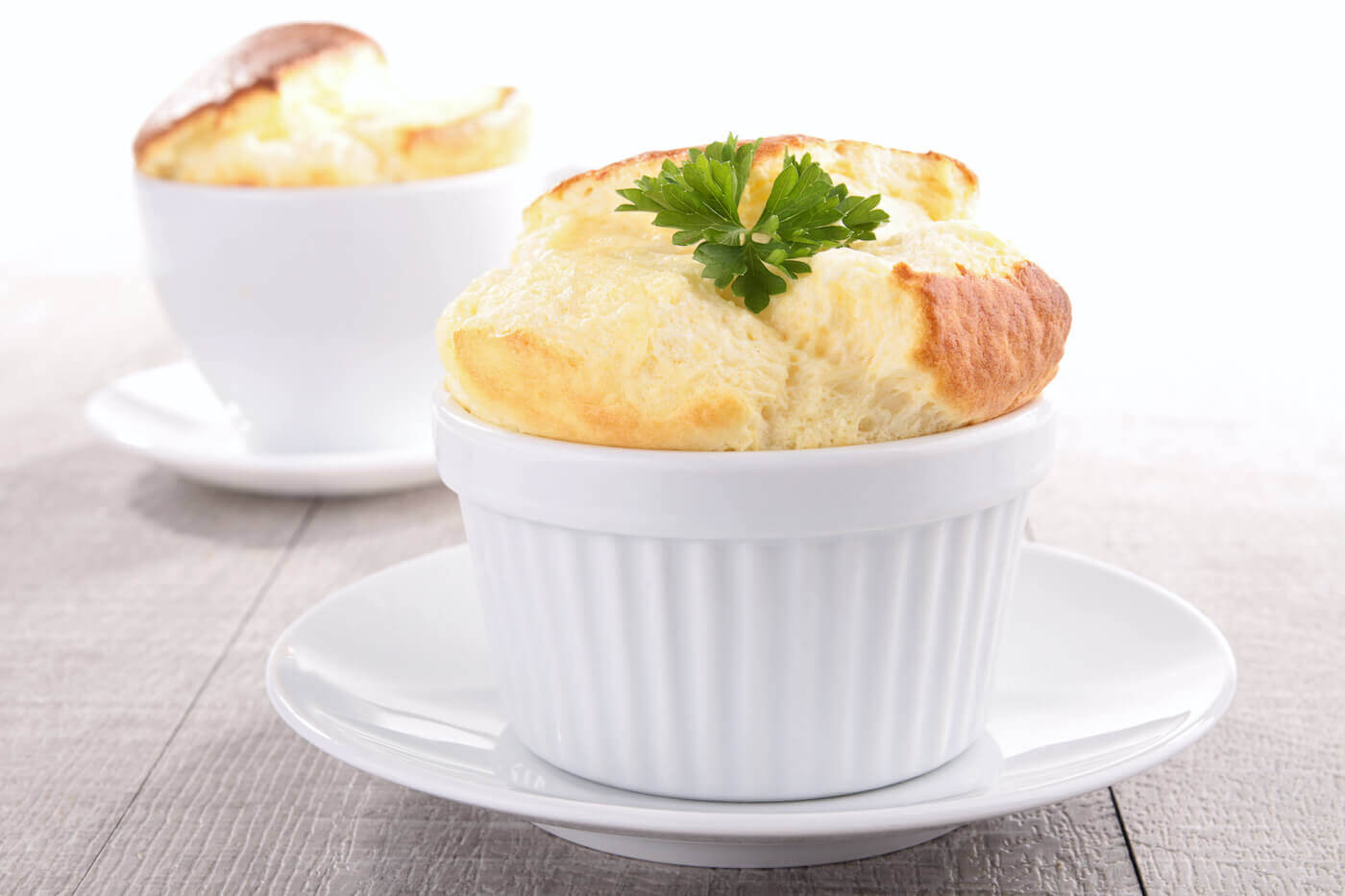How to Make a Soufflé
Few things rival the soufflé’s reputation among nerve-wracking things to bake.
We’re here to take the elements of suspense and chance out of it and to reassure you that almost anyone can bake a soufflé that stands tall and doesn’t collapse upon itself. While they can be a bit touchy, soufflés are not as difficult to make as you might think.
Follow these steps to find out how to make this light and airy dish.
What Is Soufflé?
Soufflé is an egg-based pastry, often baked in a ramekin, that puffs up when baked; its name comes from the French for “inflate.” It includes a base made of egg yolks and other ingredients that are folded into beaten egg whites, and it can be sweet—with chocolate, berries, or a sweet puree—or savory, with meat and cheese.
French chef Marie-Antoine Carême is credited with perfecting the soufflé and bringing it to the Parisian masses when he published his cookbook “Le Pâtissier Royal Parisien” in 1815. It became popular in the U.S. in the early to mid-1900s.
The Suspense is Killing Me—The Soufflé Fear Factor
When done right, a soufflé bakes up above the top of its ramekin or soufflé dish and stands tall; it is light and airy with a crunch on the outside, and it jiggles a little if you shake the dish.
But soufflés are also known to fold and collapse onto themselves like an inflatable lawn decoration that’s just been unplugged. It’s a sad scene to look upon a cratered soufflé. Though they are delicious, half the fun is in the presentation.
Some deflating is bound to happen after they come out of the oven and start to cool, but a total collapse indicates that something has gone wrong.
Culinary & Pastry Career Survey
Culinary & Pastry Career Survey
What's your ideal culinary career? Answer 20 simple questions and see if your dream career gets revealed to you.
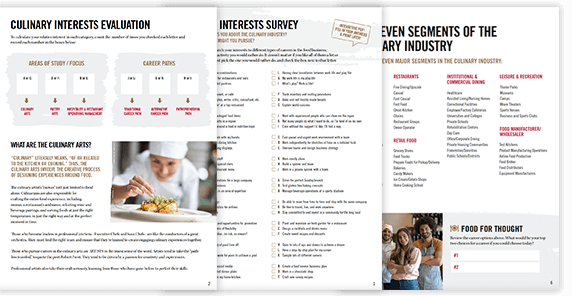
We’ve compiled of all of the essential questions into one handy guide: Career options, description of skill requirements, and more!
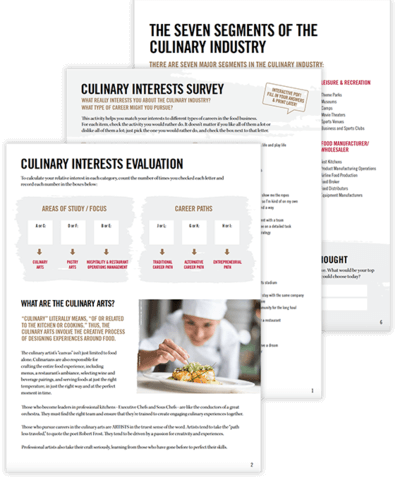

The Science Behind the Poof
The key to making a soufflé that rises high lies in beating the egg whites. The whisking produces air bubbles, or pockets, in the whites.
Because the whites are all protein, those bubbles have a delicate film of protein protecting them, and any fat that’s present during the whisking will interfere with the bubbles’ ability to form. When the soufflé goes into the oven, those bubbles expand when heated, and the film gets a little firmer as well.
It’s a delicate, even precarious, process, and if anything causes that bubble to burst—womp womp.
Ingredients for a Chocolate Soufflé
A basic chocolate soufflé recipe for a 1 ½-quart soufflé dish typically includes:
- ½ cup unsalted butter
- 8 oz. semi-sweet or bittersweet chocolate
- 6 large eggs
- ½ tsp cream of tartar
- ⅛ tsp salt
- 4 tbsp granulated sugar
Steps to Make Soufflé
A basic soufflé has relatively few steps, but they need to be carried out precisely.
Separate egg whites and yolks
First, separate the egg whites and the yolks; you’ll use the yolks for the base and beat the egg whites into a meringue.
Reminder: make sure no yolk gets into the whites because the proteins will tamper with the egg whites’ chemistry and potentially interfere with their ability to rise. You can carefully pass the yolk from one half of the broken eggshell to the other (think cartoon mad scientist mixing a potion between two beakers), and the whites will fall naturally into a waiting bowl, as seen here:
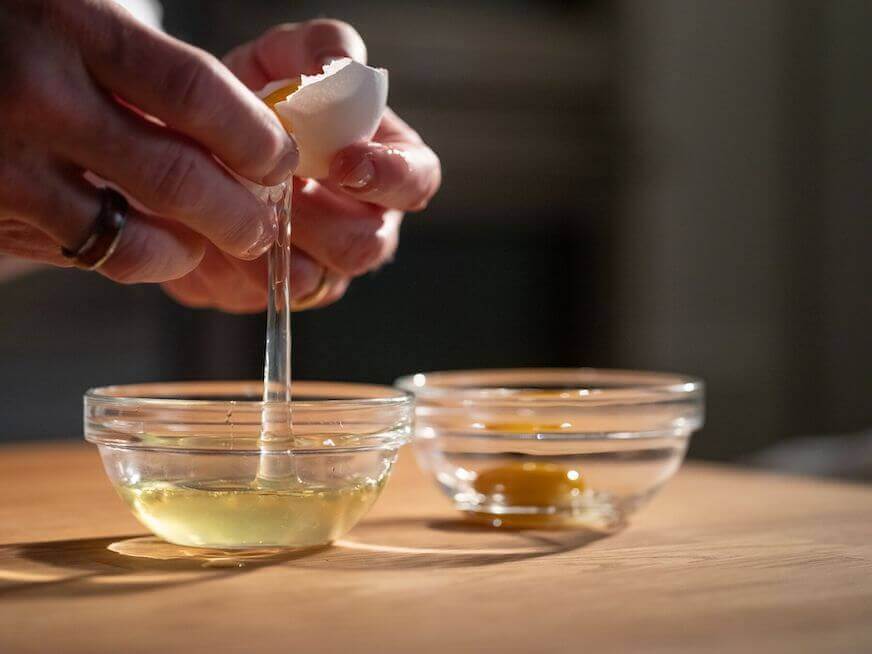
With care, you can use the eggshell to help you separate the yolk from the white.
Make the Base
Next—before whisking the whites—mix the yolks with the other ingredients for the base. You want to make the base before whipping the egg whites because the meringue shouldn’t stand for too long, lest the delicate air pockets start to burst.
Sweet ingredients for your base might include things like sugar and chocolate, sauces, fruit, and more. Savory bases may use cheese and meats, and might even be cooked before folding into the egg whites.
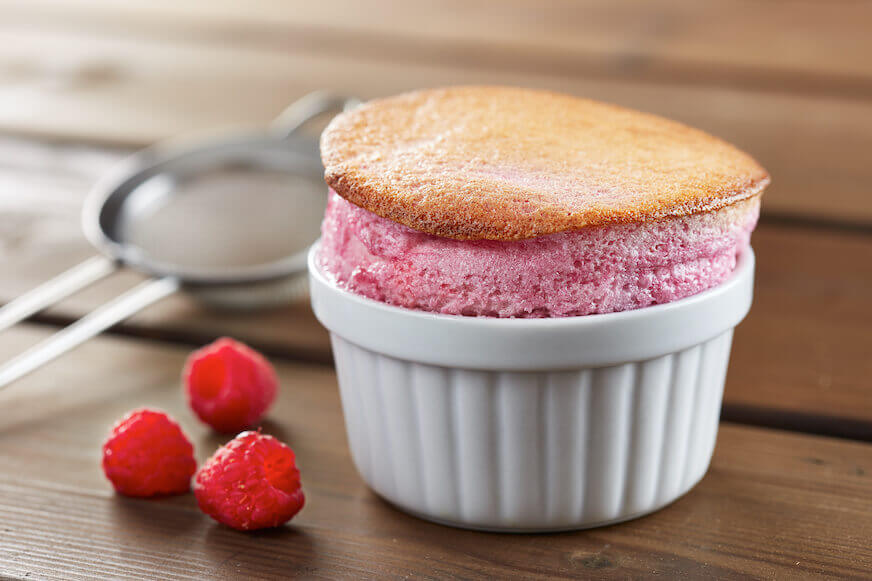
Soufflés can be sweet or savory, limited only by your imagination.
Beat the Egg Whites
Now for the most important step: the whisking of the egg whites to create those vital air pockets.
Add about a half teaspoon of cream of tartar to the whites (you’ll generally use around six eggs) and beat until stiff peaks form; the meringue should look glossy.
You’ll go through a couple of stages here: beat the egg whites until soft peaks form, then add your sugar a little at a time and keep beating until the egg whites form stiff peaks and have that glossy appearance. Don’t overbeat the egg whites or the mixture could fall apart and become grainy.
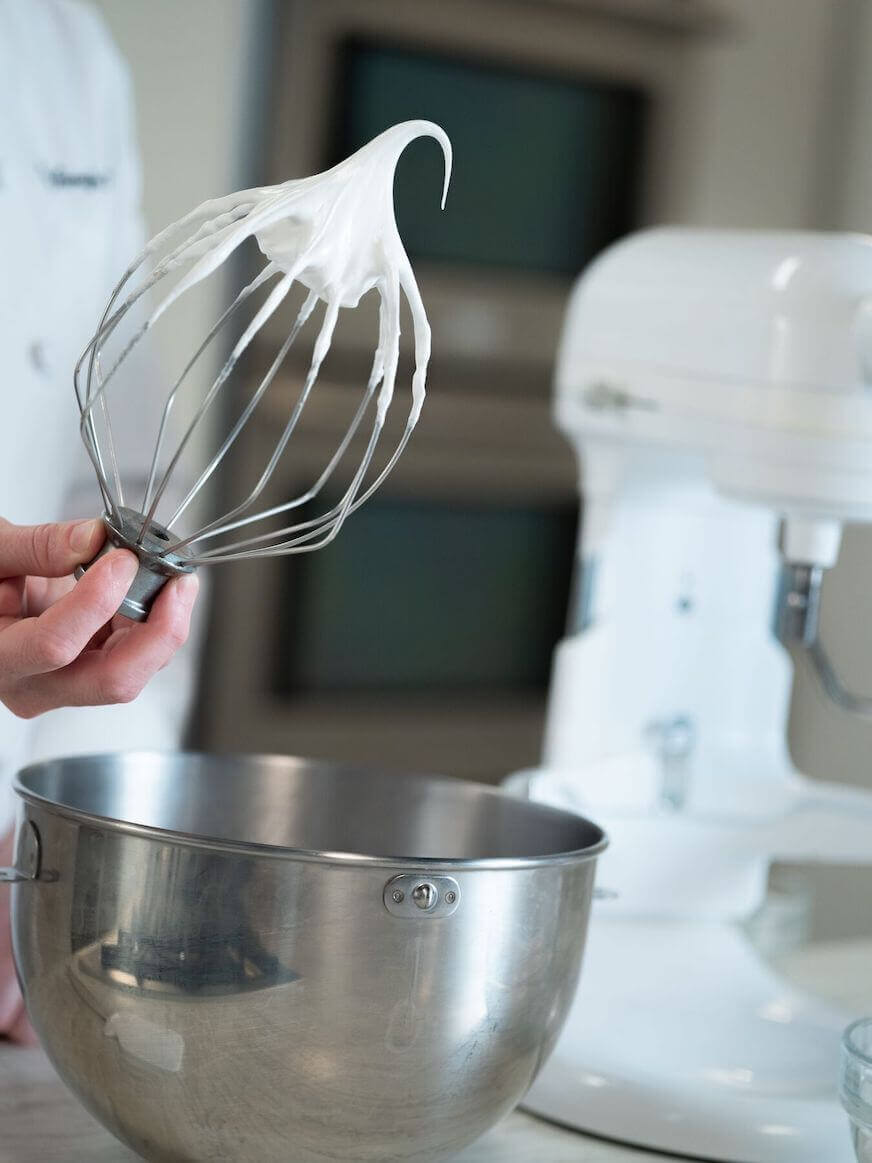
Beat egg whites until stiff peaks form, which means air bubbles have formed.
Fold the Egg Whites Into the Base
The peaks of the egg whites will start to lose some structure, so move quickly to fold the whites into the yolk mixture.
This only takes about three stirs or folds; you want to mix until combined so you keep the air in the egg whites. If you see some white streaks, that’s ok. Better to “undermix” by a smidge than to overmix so the batter doesn’t deflate.
Pour Into a Dish or Ramekin
Some soufflé dishes have a collar, and some people add one with aluminum foil in order to make the soufflé rise higher. If your dish has a collar, fill it all the way to the top of the pan. If it doesn’t have one, three-quarters of the way will do.
Bake It!
Bake time and temperature depend upon the specific recipe, but in general, a soufflé will bake in a 1 ½-quart soufflé dish at 400 degrees Fahrenheit for about 30 minutes. If using individual ramekins—usually, four six-ounce dishes—reduce the temperature to 375 degrees Fahrenheit and bake for about 15 minutes. The soufflé is ready when it’s puffed up and golden.
Note: don’t open the oven door to peek! That brief change in temperature can be enough to cause it to deflate.
Tips and Tricks To Prevent Soufflé Disaster
There are all kinds of recipes and variations, but these tips will help you create a billowy masterpiece regardless of flavor.
Use Room-Temperature Eggs
Eggs at room temperature trap air bubbles better than cold eggs, and eggs are also easier to separate when they’re at room temp instead of cold.
You can set the eggs out about two hours before you need to use them, or you can speed up the process by putting the eggs into a bowl of warm (not hot) water for about five minutes to bring them up to temperature.
Wash Your Hands
You should be in the habit of washing your hands before cooking, but in this case, the hand-washing also helps prevent residue from getting into the egg whites. Just like yolks can interfere with the egg whites, so can any oil or other foreign particles on your hands.
Crack the Egg on a Flat Surface so the Shell Doesn’t Pierce the Yolk
It’s very important to keep the yolks out of the egg whites; even a trace amount can break up the protein around the air bubbles. Break the egg gently to ensure the yolk doesn’t get pierced, as that will make it much more difficult to separate the yolk from the whites.
One technique is to break the egg on a flat surface to prevent creating shards from the shell or busting the yolk upon impact.
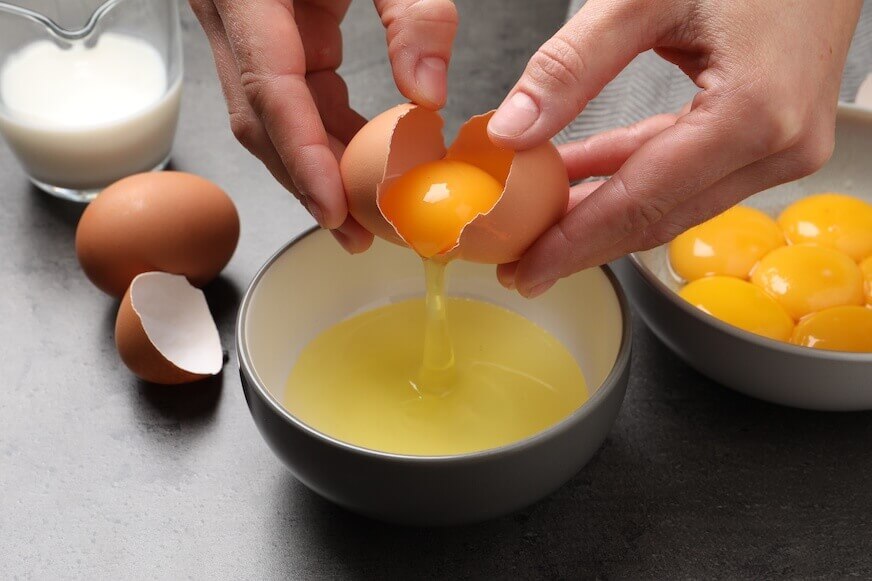
Make sure egg whites and yolks are separated and that no yolks have gotten into your egg whites when preparing your souffle ingredients.
Use a Metal Bowl to Beat Egg Whites
Many chefs swear by a copper bowl for beating egg whites, but any metal bowl will do better than plastic ones, which can trap oils and other residue. The Incredible Egg, part of the American Egg Board, recommends using stainless steel or glass.
Coat Your Dish
A simple spritz of cooking grease won’t do—you want to add a little cling to the flat sides of a ramekin or soufflé dish to allow the soufflé to rise and stand tall. Instead, coat the inside of the pan with butter and then add a dry ingredient. This ensures that the souffle doesn’t stick to the dish, and also doesn’t make it greasy.
If you’re making a sweet soufflé, use granulated sugar, brown sugar, or cinnamon to dust the pan. If you’re making a savory soufflé, consider Parmesan cheese or some breadcrumbs.
Cook on a Preheated Baking Sheet on the Oven’s Bottom Shelf
A preheated baking sheet can help your soufflé cook more evenly, giving it a heat source from the bottom as well as the top—which also helps prevent an implosion.
Cook evenly and from the bottom; preheat the baking sheet
What to Pair with a Soufflé
A soufflé can be great on its own, like a chocolate soufflé served for dessert. Or you can pair it with side dishes and other accompaniments.
If you’re making a cheesy or savory soufflé, consider a side of tomato soup or a side salad with a little bite to it, like one with green apples or pears and a balsamic vinaigrette. A crusty bread pairs well, too, or a serving of mixed berries.
As for sweet soufflés, a sprinkling of powdered sugar and a scoop of ice cream almost always works well.
Soufflés Don’t Have to be Scary
Once you’ve perfected a few techniques, you can create gorgeous soufflés that will wow your guests or add some fancy to a mundane weeknight dinner or dessert.
If you’d like to explore more ways to create elegant dishes in your kitchen, consider online cooking classes. Offered as a partnership between Escoffier Home Gourmet and America’s Test Kitchen, these classes can give you access to great recipes.
Interested in discovering more home gourmet cooking tips and advice? Check out these articles next!
- How to Make the Perfect Creme Brulee
- Everything You’ll Need to Make Perfect Donuts
- How to Make Petit Fours: A Brief History and Recipes
*This article originally ran on March 30, 2016, and has been updated.

